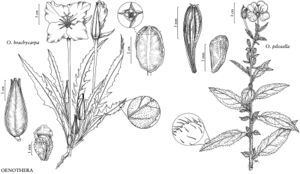Oenothera pilosella
Ann. Nat. 1: 15. 1820.
Herbs perennial, usually densely to sparsely hirsute, rarely glabrous; from a thickened base, rhizomatous. Stems spreading or ascending, unbranched or few-branched distally, 20–80 cm. Leaves in a basal rosette and cauline, basal 4–8 × 2–5 cm, petiole (0.5–)1–3(–4) cm, blade oblanceolate to ovate, margins entire; cauline 3–10(–13) × 1–2(–4) cm, petiole 0–0.5(–2) cm, blade lanceolate to ovate, abruptly narrowed to base, margins subentire or coarsely dentate. Inflorescences erect, flowers in axils of distalmost few nodes. Flowers opening near sunrise; buds with free tips 1–3 mm, spreading; floral tube 10–25 mm; sepals 10–20 mm; petals bright yellow, fading pale pink or pale yellow, 15–30 mm; filaments 7–15 mm, anthers 4–8 mm, pollen 85–100% fertile; style 10–20 mm, stigma exserted beyond anthers at anthesis. Capsules usually oblong-clavate to oblong-ellipsoid or ellipsoid, 4-angled or weakly 4-winged, (5–)10–15(–28) × 2–4(–5) mm, stipe (1–)3–5(–9) mm; sessile. Seeds 1 × 0.5 mm. 2n = 56.
Phenology: Flowering May–Jul(–Aug).
Habitat: Open fields, edge of woods, marshes and bottomland prairies, open disturbed sites, ditches, old fields, railroads, roadsides.
Elevation: 100–600 m.
Distribution
Ont., Ala., Ark., Conn., Ill., Ind., Iowa, Ky., La., Maine, Mass., Mich., Miss., Mo., N.H., N.Y., Ohio, Okla., Pa., R.I., Vt., Va., W.Va., Wis.
Discussion
Oenothera pilosella is widespread in cultivation in gardens and frequently escapes and becomes naturalized; the northern and eastern natural limits of O. pilosella are not clear. According to G. B. Straley (1977) the natural limits are from Wayne County, West Virginia, along the Ohio River and Erie County, New York, for the eastern limits, and Tuscola County, Michigan, and Manitowoc County, Wisconsin, for the northern limits. K. N. Krakos (2014), based on new field studies and phylogenetic data, found that O. pilosella does not form a monophyletic group with plants previously treated by Straley as O. pilosella subsp. sessilis in molecular analyses, and thus is here reinstated as the distinct species O. sessilis. Straley determined that O. pilosella is self-incompatible and an octoploid, one of the few in the genus.
Selected References
None.
